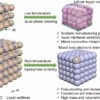Microorganisms collected from the material in which button mushrooms are grown may benefit the development of future fungi crops, according to a study led by researchers in Penn State’s College of Agricultural Sciences and published in the journal Fungal Biology.
The team examined the effects of enriching mushroom casing—a layer of material, usually peat-moss, that helps retain moisture in mushroom beds—with casing used in a previous crop, a process called “passaging” which transfers some of the microbiome in the process.
The researchers found that mushrooms grown in this microbiome-enriched casing reached their “pinning” stage—when the fungi start to fruit—earlier than those grown in standard casing. They also were more resistant to bacterial blotch, a common mushroom pathogen. However, these mushrooms were more prone to another common infection, green mold disease, when the pathogen was introduced.
Eoin O’Connor, postdoctoral scholar in plant pathology and environmental microbiology and lead author on the paper, said the findings are another step in identifying beneficial microorganisms that potentially could be used to improve mushroom harvests and prevent disease.
“While this approach shows promise for improving early development and suppressing bacterial blotch, its tendency to amplify green mold disease expression highlights the need for further studies,” O’Connor said. “Ideally, future research could help identify a set of microbes that provides the desirable traits of passaged casing without the potential negative side effects.”
Button mushrooms are grown around the globe, the researchers said, but are a particularly significant crop in Pennsylvania, which produces almost two-thirds of the U.S. supply.
O’Connor said the team’s previous research found that manipulating the microbial communities in mushroom casing was associated with early mushroom production. In this study, they wanted to explore the effect of this casing on two major mushroom diseases: bacterial blotch and green mold.
“These economically important diseases are responsible for causing significant crop losses in button mushroom cultivation,” he said. “By addressing these diseases, this work contributes to developing sustainable practices for mushroom cultivation and offers a model system to study the broader impact of microbiomes on horticultural productivity.”
To begin the study, the researchers grew a standard crop of button mushrooms and carefully gathered the casing once the fungi started to fruit. They added the collected casing—which by that point potentially had developed a microbiome uniquely adapted to button mushrooms—to fresh casing in a one to 10 ratio.
This enhanced casing was used to grow a new batch of mushrooms, and the process was repeated a total of 10 times.
Using this final batch of casing, the researchers then tested its effects on mushroom growth and disease dynamics. Experimental treatments involved inoculating both the treated and standard casings with either P. tolaasii, one of the bacteria that causes bacterial blotch, or T. aggressivum, the pathogen that causes green mold disease, and comparing the results.
Discover the latest in science, tech, and space with over 100,000 subscribers who rely on Phys.org for daily insights.
Sign up for our free newsletter and get updates on breakthroughs,
innovations, and research that matter—daily or weekly.
They found that compared to standard casing, mushrooms grown in the treated casing reached the pinning stage up to three days earlier, which, O’Connor noted, reproduced findings from their previous study.
Additionally, they found that the treated casing had a suppressive effect on bacterial blotch. Using treated casing resulted in significantly more mushrooms without bacterial blotch symptoms, and mushrooms that did develop the disease showed milder symptoms than those grown in standard casing.
In contrast, passaged casing worsened the effects of green mold disease, leading to lower yields of mushrooms from passaged casing inoculated with T. aggressivum compared to the same treatment with standard casing.
O’Connor said the study is important not just for its possible future applications in mushroom farming, but also for understanding the importance of devomes—the microbiome of a developing organism—in general.
“This research underlines the value of Penn State’s Mushroom Research Center, a unique facility that makes studies like this possible,” O’Connor said. “The findings demonstrate the broader implications of understanding devomes—not just for mushrooms, but also for other horticultural systems, and lay the groundwork for future innovations in sustainable crop and disease management.”
More information:
Eoin O’Connor et al, Manipulating button mushroom casing affects the disease dynamics of blotch and green mold disease, Fungal Biology (2024). DOI: 10.1016/j.funbio.2024.11.001
Provided by
Pennsylvania State University
Citation:
Harnessing mushroom microbiomes for better crop development (2025, January 27)



